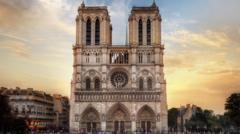In a spectacular display of resilience and dedication, Paris's historic Notre-Dame Cathedral is set to reopen on December 7, 2024, marking five years since the devastating fire that nearly destroyed the iconic structure. President Emmanuel Macron, along with his wife Brigitte and Paris's Archbishop Laurent Ulrich, launched a series of ceremonies on November 3, 2024, previewing the cathedral's striking renovations.
The €700 million restoration project has transformed Notre-Dame, with whispers of awe surrounding its revamped interior, now graced with a brightness that starkly contrasts its former gloom. A close insider from the Elysée expressed that the reopening day "will echo 'splendour'" as visitors reconnect with the cathedral's majesty. The restoration included replacing the medieval roof with massive beams that faithfully echo the original design lost to the flames.
The fateful night of April 15, 2019, still lingers in collective memory, as live broadcasts captured the inferno devouring the roof and toppling the 19th Century spire. Despite initial fear of total ruin, 600 firefighters battled for 15 tireless hours to save the structure, managing to protect vital elements like the stained-glass windows and the renowned Crown of Thorns.
Macron's pledge to reopen within five years seemed daunting at the time, yet a public fund-raising effort saw an outpouring of support, accumulating €846 million from generous sponsors and citizens alike. The endeavor attracted around 2,000 craftsmen from various disciplines, reviving traditional trades and leading to an increase in apprenticeships across France’s art and crafts sectors.
However, controversy arose regarding the modern imprint of the restoration, particularly concerning plans for stained-glass windows in six side-chapels. Despite proposals for contemporary designs, much of the restoration has remained faithful to the historical integrity of the cathedral, utilizing modern materials primarily for safety improvements.
As the official reopening date approaches, the project has transcended mere restoration, embodying a shared will among the French. Macron's passionate involvement in the project aims to foster national pride amidst political struggles, positioning Notre-Dame as a symbol of collective resilience. As one insider noted, "What people will see in the new Notre Dame is the splendour and the strength of collective will-power – à la française."
The rebirth of Notre-Dame is not just an architectural triumph but a poignant reminder of the bonds that unite people in times of sorrow and hope, as they prepare to step back into its glorious embrace once more.
The €700 million restoration project has transformed Notre-Dame, with whispers of awe surrounding its revamped interior, now graced with a brightness that starkly contrasts its former gloom. A close insider from the Elysée expressed that the reopening day "will echo 'splendour'" as visitors reconnect with the cathedral's majesty. The restoration included replacing the medieval roof with massive beams that faithfully echo the original design lost to the flames.
The fateful night of April 15, 2019, still lingers in collective memory, as live broadcasts captured the inferno devouring the roof and toppling the 19th Century spire. Despite initial fear of total ruin, 600 firefighters battled for 15 tireless hours to save the structure, managing to protect vital elements like the stained-glass windows and the renowned Crown of Thorns.
Macron's pledge to reopen within five years seemed daunting at the time, yet a public fund-raising effort saw an outpouring of support, accumulating €846 million from generous sponsors and citizens alike. The endeavor attracted around 2,000 craftsmen from various disciplines, reviving traditional trades and leading to an increase in apprenticeships across France’s art and crafts sectors.
However, controversy arose regarding the modern imprint of the restoration, particularly concerning plans for stained-glass windows in six side-chapels. Despite proposals for contemporary designs, much of the restoration has remained faithful to the historical integrity of the cathedral, utilizing modern materials primarily for safety improvements.
As the official reopening date approaches, the project has transcended mere restoration, embodying a shared will among the French. Macron's passionate involvement in the project aims to foster national pride amidst political struggles, positioning Notre-Dame as a symbol of collective resilience. As one insider noted, "What people will see in the new Notre Dame is the splendour and the strength of collective will-power – à la française."
The rebirth of Notre-Dame is not just an architectural triumph but a poignant reminder of the bonds that unite people in times of sorrow and hope, as they prepare to step back into its glorious embrace once more.





















